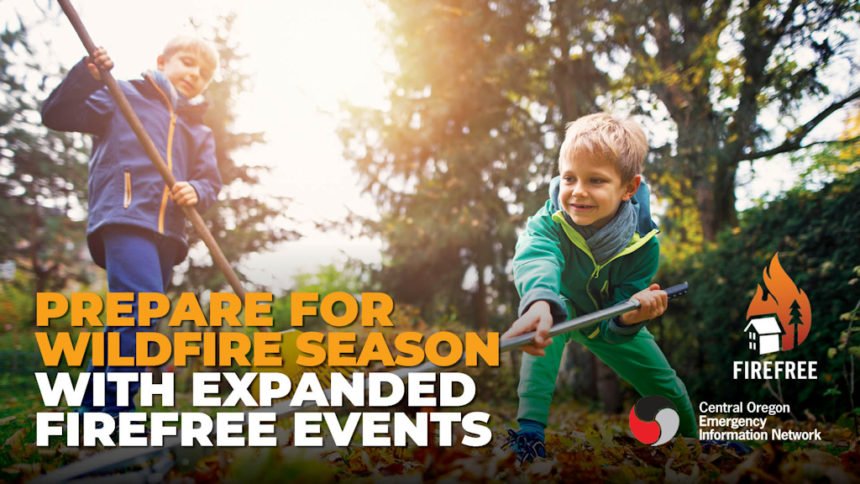Expanded FireFree yard debris recycling events coming up

BEND, Ore. (KTVZ) -- Central Oregonians are staying home to help prevent the spread of COVID-19. This time at home provides a unique opportunity to prepare for fire season and take advantage of upcoming free yard debris recycling events.
Wildfire season is quickly approaching, and Central Oregon has had a drier than average winter this year. Due to the dry winter, our area is seeing low fuel moisture levels, and the long-term forecast looks like we could have an early fire season in the Pacific Northwest. This means we have an elevated risk of larger fires in our area, so Central Oregon fire personnel are already gearing up for a busy fire season.
COVID-19 could create some increased challenges to our fire season. Keeping wildland firefighters healthy and adhering to social distancing through this wildland season may be difficult. The goal will be to keep wildland fires small and focus on prevention efforts. This is where our community can help by preparing their homes and creating defensible space to get it fire ready.
Residents are asked to wear masks when they drop off their yard debris and to keep an appropriate space between themselves and other vehicles. Department of Solid Waste staff will conduct Fire Free events to allow for proper physical distancing between participants.
Now is the time to clean up your yards, create defensible spaces around homes and recycle that debris at FireFree collection sites FOR FREE in Crook, Deschutes and Jefferson counties.
This year, Deschutes County will offer expanded FireFree event dates from May 9 to May 24 at Knott Landfill and local transfer stations. In partnership with Brooks Resources and Bend Fire & Rescue, the Bend west side location will also be open for three weekends in May.
Deschutes County:
(The following sites will be open May 9-24, unless otherwise noted) Date was incorrectly listed as 4 in orignal version.
- Bend:
- Knott Landfill; May 1 to October 31 hours: 7 a.m. to 5 p.m.; 61050 SE 27th Street, Bend
- Westside Collection Site - Discovery West/Brooks Resources; weekends only; Crossing Drive at Skyliners Road - west of Miller Elementary (Crosby Dr.), near the Tree Farm subdivision
- La Pine: Southwest Transfer Station; Wednesday - Saturday, 8 a.m. to 4 p.m.; 54580 Highway 97, La Pine
- Redmond: Negus Transfer Station, Monday - Saturday, 8 a.m. to 4 p.m.; 2400 NE Maple Way, Redmond
- Sisters: Northwest Transfer Station; Wednesday - Saturday, 8 a.m. to 4 p.m.; 68200 Fryrear Road, Cloverdale
- Sunriver: Sunriver Compost Site; May 15-16, 8 a.m. to 4 p.m.; 18305 Cottonwood Road, Sunriver
Additionally:
Crook County:
- Crook County Landfill in Prineville: Saturday, April 25
Jefferson County:
- Madras: Box Canyon Transfer Site; June 13-14 and 20-21
Frequently Asked Questions
What can I drop off?
- Grass clippings, brush, plant prunings, pine needles, pine cones, weeds, trimmings and branches, stumps or trees (no larger than 12” in diameter).
- NOT Accepted: rocks, lumber, metal, trash or plastics of any kind, including plastic bags. Sod and dirt.
Where are the most vulnerable places for glowing embers to ignite my home?
- Gutters and roof valleys with debris like pine needles and leaves. Clean them out. Despite a metal or asphalt shingle roof, the buildup of gutter debris provides necessary fuel for the glowing embers to ignite adjacent fascia boards or siding – most often made of wood.
- Shrubs and weeds that provide a path of fuel for fire to reach your trees or home. Reduce shrubs and other “ladder fuels” around your home to reduce the threat of ground fires igniting nearby trees, or your home.
- Flammable materials near a deck, patio or fence. Remove weeds, shrubs or any combustible materials from around, under or on top of your deck, patio or wood fence. This includes toys, planters, construction materials, patio furniture and cushions along with even small piles of pine needles or leaves.
- Bark mulch, pine needles, ornamental junipers or flammable vegetation within 5 feet of your home. This can provide the perfect ember bed that provides necessary fuel for the glowing embers to ignite the adjacent siding – most often made of wood.
- Woodpiles near your home or other combustible vegetation. Move woodpiles at least 30 feet away from your home or other combustibles.
- Visit the FireFree website at www.firefree.org for more information about how you can prepare your property for wildfire season.